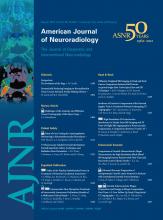Abstract
BACKGROUND AND PURPOSE: CVJ lesion suffers from a high sensitivity to susceptibility and distortion artifacts, which sometimes makes diffusion image difficult to interpret. Our purpose was to evaluate the potential for diffusion MR imaging using RS-EPI compared with SS-EPI in the assessment of the CVJ.
MATERIALS AND METHODS: RS-EPI and SS-EPI DTI images were acquired from 10 healthy volunteers using 3T MRI with a 32-channel head coil. For both sequences, the following parameters were used: 1-mm2 in-plane resolution; 3-mm section thickness; TR = 5200 ms; 1 acquisition at b = 0 and 12 different encoding directions at b = 1000 seconds/mm2. The RS-EPI sequence scan time was 9.44 minutes (1 average). The SS-EPI sequence was 9.37 minutes (8 averages). Diffusion tensor calculation and image analysis were performed using DTIStudio software. Diffusion trace images and color-coded fiber orientation maps were evaluated by 2 independent readers for distortion and delineation of fine structure using a semiquantitative scale in selected landmark locations. The absolute distances between the temporal base and the cerebellar contour between the T2-weighted images and the diffusion trace images obtained with RS-EPI and SS-EPI were also compared.
RESULTS: The contours of the temporal lobe and cerebellum were better delineated and distortion artifacts were clearly reduced with the RS-EPI sequence. More fine structures were also visible in the brain stem and cerebellum with the RS-EPI sequence. The amount of distortion was significantly reduced with RS-EPI compared with SS-EPI (P < .01).
CONCLUSIONS: The RS-EPI DTI sequence was less prone to geometric distortion than the SS-EPI sequence and allowed a better delineation of CVJ internal structure. Although the acquisition time is still relatively long, the RS-EPI appears as a promising approach to perform DTI studies in CVJ lesions, such as brain stem ischemia, neurodegenerative diseases, brain and skull base tumors, or inflammation.
ABBREVIATIONS:
- CVJ
- craniovertebral junction
- FA
- fractional anisotropy
- GRAPPA
- generalized autocalibrating partially parallel acquisition
- MD
- mean diffusivity
- RS
- readout–segmented
- SS
- single-shot
- © 2012 by American Journal of Neuroradiology
Indicates open access to non-subscribers at www.ajnr.org












